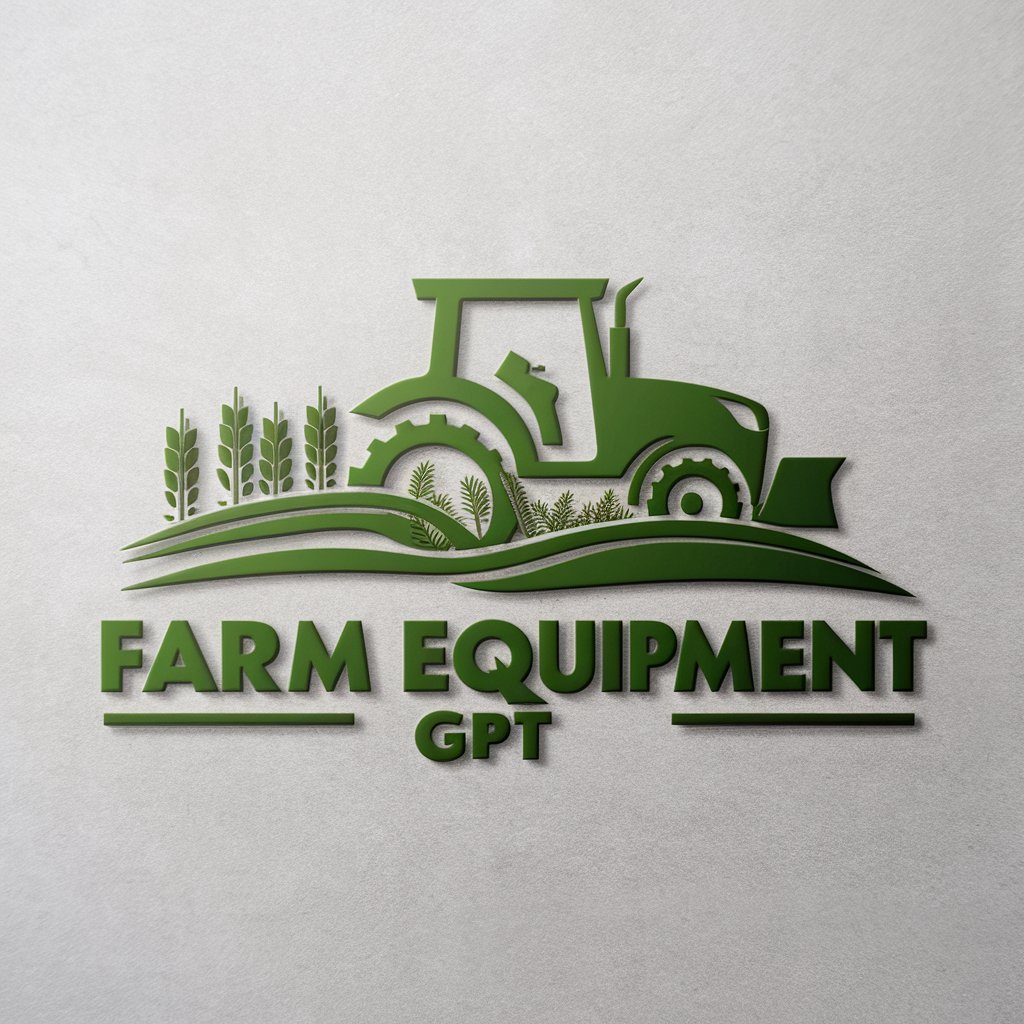Farm Equipment - Farm Equipment Insights

Welcome! How can I assist you with farm equipment today?
Empowering agriculture with AI-driven solutions
What are the best tractors for small farms?
How do I maintain my combine harvester?
Can you recommend a plow for clay soil?
What features should I look for in a new seeder?
Get Embed Code
Overview of Farm Equipment GPT
Farm Equipment GPT is designed to serve as a comprehensive guide and advisor on agricultural machinery and tools. Its core purpose is to provide detailed information, recommendations, and practical advice on the selection, use, and maintenance of various types of farm equipment. This includes, but is not limited to, tractors, harvesters, plows, and irrigation systems. The design purpose of Farm Equipment GPT is to bridge the knowledge gap between complex agricultural machinery technology and the end-users who may not have in-depth technical knowledge. Examples of its utility include guiding a small-scale farmer in choosing the right tractor for their land size and type of farming, advising on the maintenance schedule of a harvester to optimize its lifespan, and suggesting the best irrigation system for a particular crop type and climate condition. Powered by ChatGPT-4o。

Core Functions and Applications
Equipment Selection Guidance
Example
Advising on the best type of tractor for a 50-acre soybean farm.
Scenario
A farmer needs to upgrade their tractor to enhance efficiency and productivity. Farm Equipment GPT assesses factors like farm size, soil type, and budget to recommend a suitable tractor model, emphasizing fuel efficiency, power, and adaptability to soybean farming tasks.
Maintenance and Repair Tips
Example
Providing a maintenance checklist for a combine harvester.
Scenario
Ahead of the harvest season, a harvester owner seeks advice on preparing their machine. Farm Equipment GPT offers a detailed checklist covering engine maintenance, blade sharpening, and cleaning protocols to ensure optimal performance and reduce downtime.
Innovations in Farm Technology
Example
Introducing precision farming tools and how they can optimize crop yields.
Scenario
A farmer interested in increasing crop yields with minimal environmental impact is guided through the adoption of precision farming technologies, such as GPS-guided equipment and soil sensors, illustrating how these tools lead to more efficient use of resources and higher yields.
Target User Groups
Small to Medium-Scale Farmers
This group benefits from personalized equipment recommendations and practical advice on optimizing farm operations with limited resources. Farm Equipment GPT helps them make informed decisions that match their specific needs, enhancing productivity and sustainability.
Agricultural Students and Educators
Students and educators in agricultural fields gain access to a wealth of information on farm machinery, staying updated on the latest technologies and practices. Farm Equipment GPT serves as an educational resource, enriching their learning and teaching experiences.
Agricultural Equipment Dealers and Technicians
Professionals involved in the sale and maintenance of farm equipment use Farm Equipment GPT to stay informed about the latest machinery specs, maintenance tips, and industry trends, providing better service to their clients and staying competitive in the market.

How to Use Farm Equipment Guide
Start with a Free Trial
Initiate your journey by exploring farm equipment functionalities at yeschat.ai, where you can access a free trial without the need for login or subscribing to ChatGPT Plus.
Identify Your Needs
Assess your agricultural requirements to determine the type of farm equipment that best suits your operation. Consider factors such as farm size, crop types, and specific tasks like tilling, planting, or harvesting.
Safety First
Prioritize safety by familiarizing yourself with the equipment's operation manuals. Understand safety protocols and wear appropriate protective gear, ensuring a safe working environment.
Hands-on Practice
Engage in practical training or demonstrations to gain hands-on experience with the equipment. Practice in a controlled setting to build confidence and proficiency before actual field application.
Regular Maintenance
Maintain equipment performance and longevity through regular maintenance. Check for wear and tear, lubricate moving parts, and perform routine inspections to prevent breakdowns and ensure efficient operation.
Try other advanced and practical GPTs
Flooring Tools
Empowering Your Flooring Projects with AI

Meditation Tools
Empower your inner journey with AI

AI Tool
Unleashing Creativity with AI

Agile Mentor
Empowering Agile Journeys with AI

Your Copywriter SEO
Elevate Your Content with AI Power

REPP Campagne assistent
Empowering Real Estate Marketing with AI

Free SEO tools for content writing
Empower Your Writing with AI-driven SEO Insights

Equipment Parts
Empowering Equipment Excellence with AI

Equipment Rental
Smart AI for Smart Rentals

Ecom Store Optimization
Optimize Your Store, Maximize Your Sales

ContentWizard AI
Empower Your Words with AI

AI Sheikh
Empowering Islamic Inquiry with AI

Detailed Q&A on Farm Equipment
What types of farm equipment are essential for a small-scale farm?
Essential equipment for small-scale farms includes compact tractors, tillers for soil preparation, seed drills for planting, irrigation systems for water management, and harvesters for crop gathering. Tailoring equipment choices to specific farm needs is crucial for efficiency.
How can technology improve farm equipment efficiency?
Technology enhances farm equipment efficiency through precision agriculture tools, such as GPS guidance for accurate planting, drones for crop monitoring, and software for managing farm operations. These innovations reduce waste, optimize resource use, and boost productivity.
What maintenance practices extend the life of farm machinery?
Regularly cleaning machinery, storing equipment properly, conducting pre-season checks, replacing worn-out parts, and following the manufacturer's service recommendations are key practices that extend the life of farm machinery and maintain its efficiency.
How does one choose the right tractor for their farm?
Choosing the right tractor involves considering the farm's size, the type of tasks it will perform, horsepower requirements, compatibility with existing implements, and operator comfort. Assessing these factors will help identify a tractor that meets specific farming needs effectively.
Are there eco-friendly farm equipment options available?
Yes, eco-friendly farm equipment options include electric tractors, solar-powered irrigation systems, and machinery designed for minimal soil disruption. These sustainable solutions reduce carbon emissions, decrease energy consumption, and support environmentally conscious farming practices.
